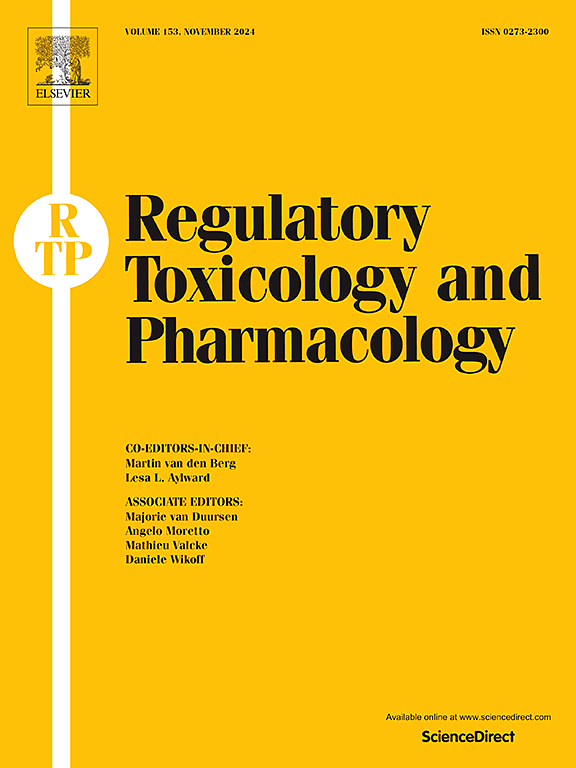非人类灵长类动物用于肿瘤治疗的非临床毒性研究包的考虑,目标明确,支持3Rs - IQ DruSafe行业调查
IF 3.5
4区 医学
Q1 MEDICINE, LEGAL
引用次数: 0
摘要
用于肿瘤的单克隆抗体(mab)的开发正在增加。IQ DruSafe工作组进行了一项行业调查,以评估非人灵长类动物(NHP)在肿瘤单克隆抗体的非临床毒性测试中的使用情况,以确定减少NHP使用的机会。该调查讨论了用于证明WchT合理性的信息来源、减少NHP使用的证据权重(WoE)方法以及非临床毒理学计划的设计。所有受访者都使用文献来定义WchT。WoE方法有助于减少一般毒理学研究的数量和规模。大多数公司在GLP毒理学研究之前进行了非良好实验室规范(非GLP)剂量范围研究,通常是非终末性的,允许潜在的nhp重复使用。对于GLP研究,大多数公司对1个月的研究保持标准设计(当进行时),但对3个月的研究更灵活,通常不包括恢复组。案例研究表明,监管部门成功地接受了精简的非临床安全包。让药品监管部门(DRA)参与讨论额外和/或专门研究的必要性,将有利于减少NHP的使用。总之,通过优化非临床毒理学方法,采用适当的战略规划、适合目的的毒理学研究设计,并与DRA讨论,可以减少NHP在开发针对WchT的肿瘤治疗中的使用。本文章由计算机程序翻译,如有差异,请以英文原文为准。
Considerations of non-human primate use in nonclinical toxicity study package for oncology therapeutics with well-characterized target in supports of 3Rs – an IQ DruSafe industry survey
Development of monoclonal antibodies (mAbs) for oncology is increasing. An IQ DruSafe Working Group conducted an industry survey to evaluate non-human primate (NHP) use in nonclinical toxicity testing of oncology mAbs for well-characterized targets (WchT) with the aim to identify opportunities to reduce NHP use. The survey addressed sources of information used to justify WchT, weight of evidence (WoE) approaches to reduce NHP use, and design of nonclinical toxicology programs. All respondents used literature to define WchT. WoE approaches helped reduce the number and size of general toxicology studies. Most companies conducted non-Good Laboratory Practice (non-GLP) dose-range finding studies prior to GLP toxicology studies, often non-terminally, allowing for potential reuse of NHPs. For GLP studies, most companies maintained a standard design for 1-month studies (when conducted) but were more flexible with 3-month studies, often excluding recovery groups. Case studies illustrate successful regulatory acceptance of streamlined nonclinical safety packages. Engaging drug regulatory authorities (DRA) to discuss the need for additional and/or specialized studies would be beneficial to reduce NHP use. In conclusion, NHP use can be reduced in developing oncology therapeutics against WchT by optimizing nonclinical toxicology approaches with appropriate strategic planning, fit-for-purpose toxicology study designs, and discussion with DRA.
求助全文
通过发布文献求助,成功后即可免费获取论文全文。
去求助
来源期刊
CiteScore
6.70
自引率
8.80%
发文量
147
审稿时长
58 days
期刊介绍:
Regulatory Toxicology and Pharmacology publishes peer reviewed articles that involve the generation, evaluation, and interpretation of experimental animal and human data that are of direct importance and relevance for regulatory authorities with respect to toxicological and pharmacological regulations in society. All peer-reviewed articles that are published should be devoted to improve the protection of human health and environment. Reviews and discussions are welcomed that address legal and/or regulatory decisions with respect to risk assessment and management of toxicological and pharmacological compounds on a scientific basis. It addresses an international readership of scientists, risk assessors and managers, and other professionals active in the field of human and environmental health.
Types of peer-reviewed articles published:
-Original research articles of relevance for regulatory aspects covering aspects including, but not limited to:
1.Factors influencing human sensitivity
2.Exposure science related to risk assessment
3.Alternative toxicological test methods
4.Frameworks for evaluation and integration of data in regulatory evaluations
5.Harmonization across regulatory agencies
6.Read-across methods and evaluations
-Contemporary Reviews on policy related Research issues
-Letters to the Editor
-Guest Editorials (by Invitation)

 求助内容:
求助内容: 应助结果提醒方式:
应助结果提醒方式:


